by Amineddoleh & Associates LLC | Feb 14, 2023 |
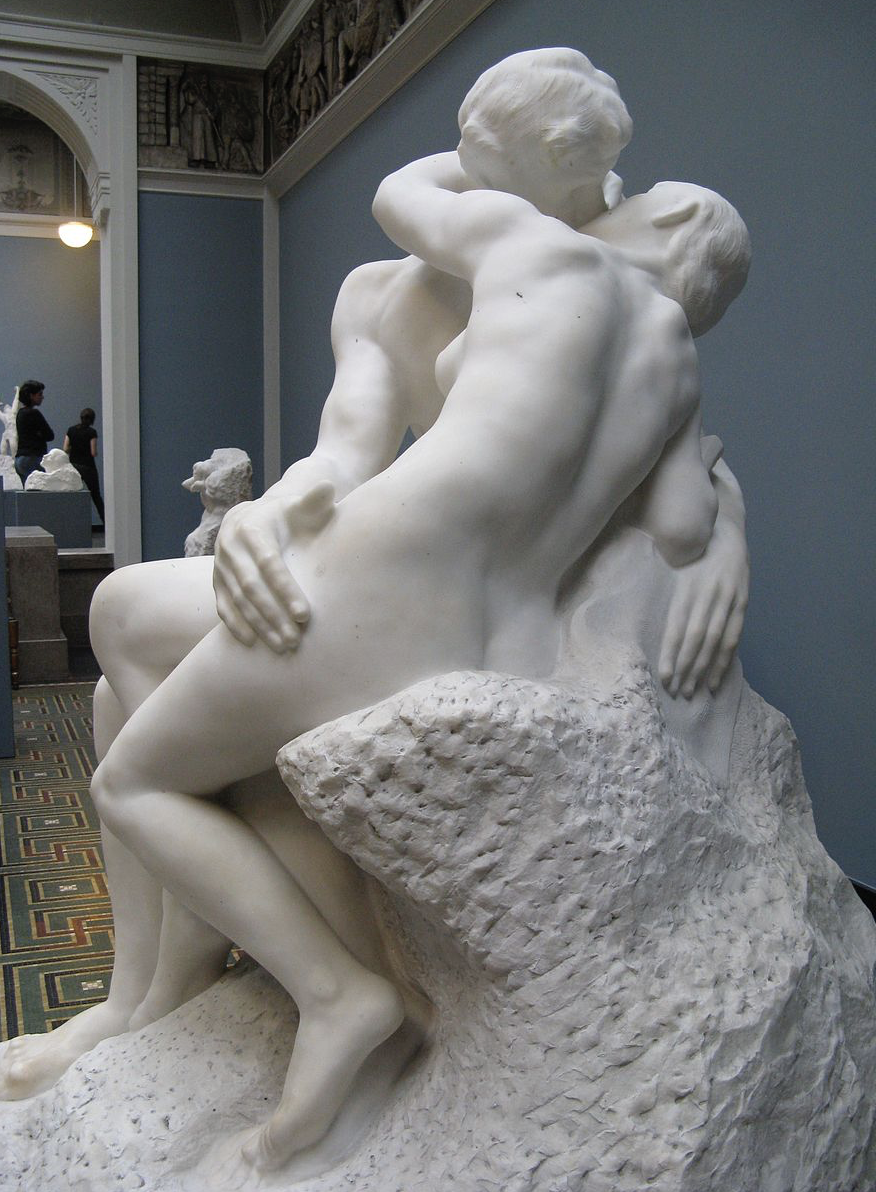
Auguste Rodin, The Kiss, Ny Carlsberg Glyptotek in Copenhagen. Image courtesy of Yair Haklai via Wikimedia Commons
It’s Valentine’s Day, and there is no better way to celebrate the holiday of romance than to highlight a famous sculpture depicting an illicit affair.
The work at the heart of today’s post is Rodin’s The Kiss. This sculpture, created with Rodin’s trademark precision and expressiveness, was inspired by Dante’s Inferno. It portrays two tragic lovers, Paolo and Francesca, locked in a passionate embrace. What makes their love so tragic is that it was doomed from the start: Paolo was Francesca’s academic tutor, and Francesca was engaged to Paolo’s brother. According to Dante’s epic, the pair’s tutoring session began routinely, but went a bit off book after Paolo began to read an Arthurian legend to Francesca. The conquests of King Arthur’s Court did it for the duo, and the physical reaction portrayed by Rodin’s statue was the saucy result.
This was a win for love, but a loss for morality. As a result, Paolo and Francesca were both damned to Hell, where the two suffered for their sins, but remained together even after death.
The Kiss is one of Rodin’s most beloved works, and it caused a stir following its production. This is likely because in 1881, the time of casting, The Real Housewives franchise was not on TV in France. Patrons looked to art for their fix of dramatic scandal and found it in The Kiss.
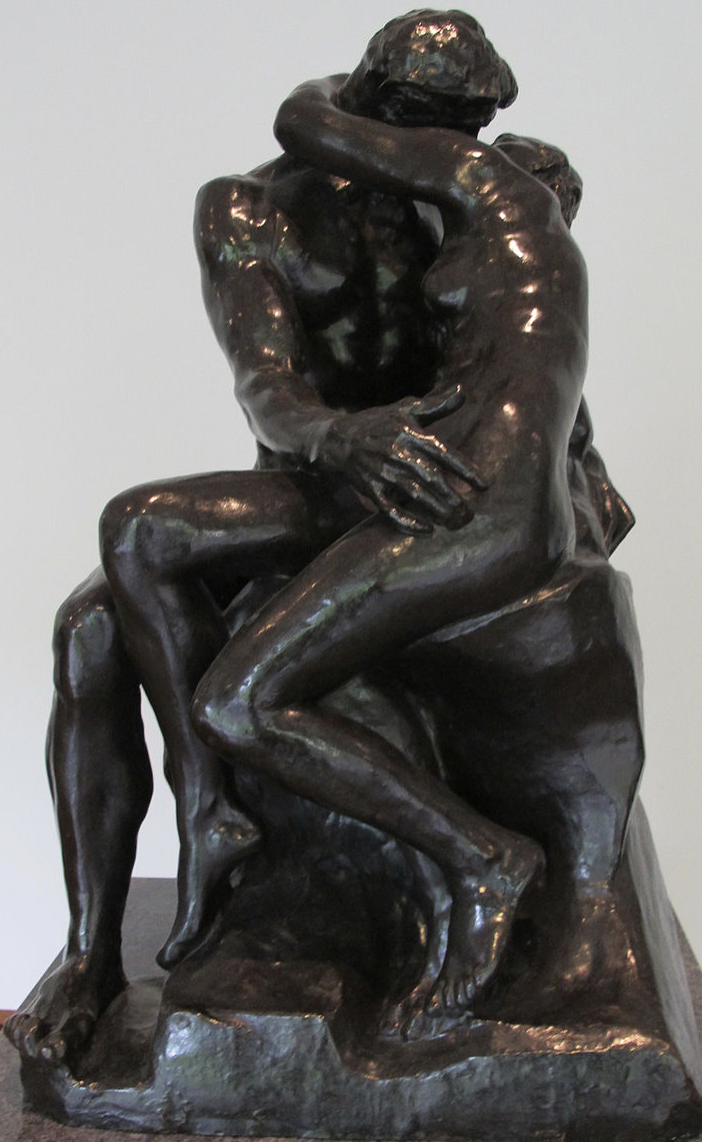
Auguste Rodin (French, 1840-1917): The Kiss, bronze, National Museum of Western Art, Tokyo, Japan, image courtesy of Sailko via Wikimedia Commons
The original sculpture of The Kiss, done in bronze, was created by Rodin as part of a commission by The Decorative Arts Museum in Paris. This museum was never established, but the commission itself ended up producing a fantastic group work by Rodin, including The Kiss. The group work, entitled The Gates of Hell, is a monumental sculpture of Rodin pieces. The Kiss was created as part of this work. However, it was later removed from the larger group and took on a life as a stand-alone piece.
Continuing to set the bar for “relationship goals,” Rodin outdid himself on another set of sculptural figures originating from The Gates of Hell. This next duo is entitled The Eternal Idol. The work shows a woman gazing down upon a man who kneels at her feet in devotion. The lovers made an impression on viewers at the time of creation. Famed poet and author Rainer Maria Rilke, who took cues from Rodin’s creative process in his own work, said of the piece that the work “[a]lways [has] the same enchanting strength. You dare not design a single meaning to it.”
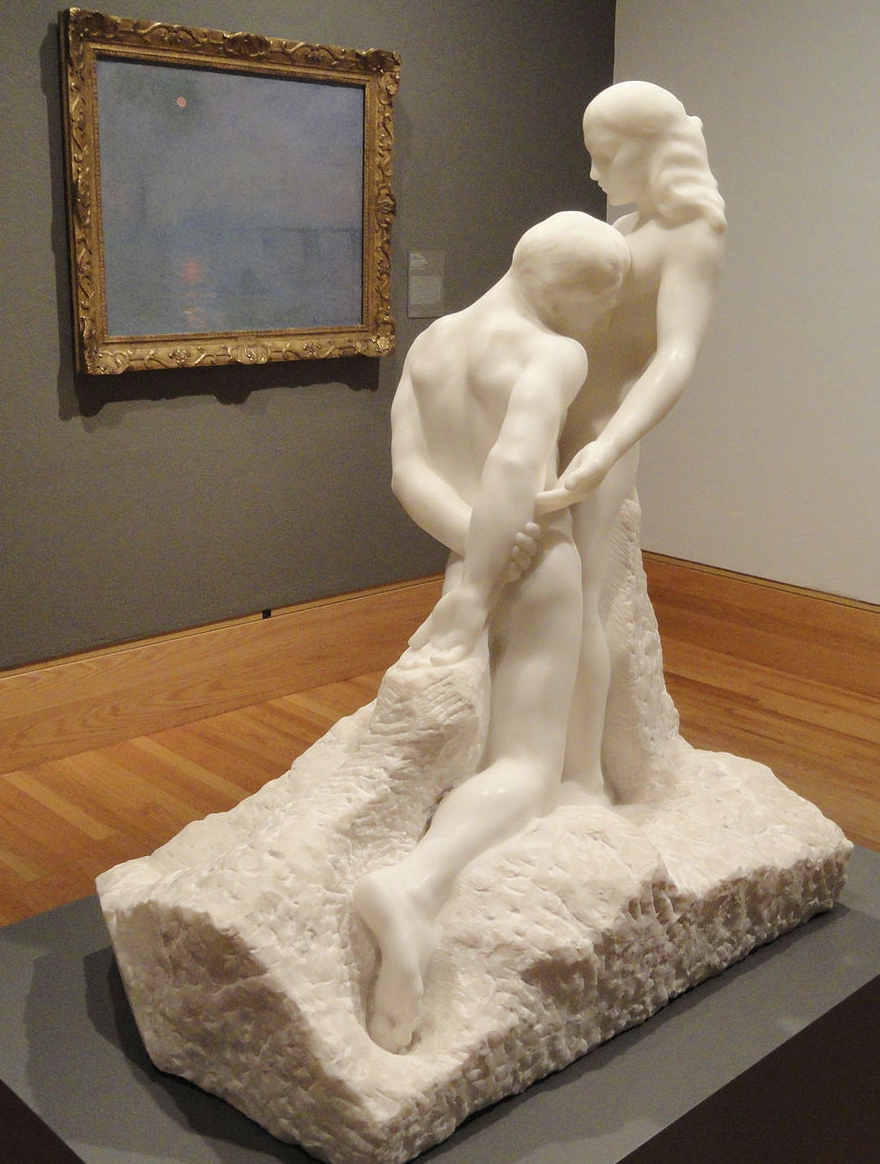
Eternal Idol, executed by Jean Escoula. Exhibit in the Fogg Art Museum, Harvard University, Cambridge, Massachusetts. Image courtesy of Daderot via Wikimedia Commons
While the meaning of the work remains mysterious, art historians have a few good guesses as to who in Rodin’s life inspired the passion portrayed in this work. It is no secret that Rodin often relied on his famous sculptor and colleague Camille as inspiration, model, and muse. The best evidence of the romantic entanglement between the two comes from Rodin’s surviving letters to Camille Claudel. Rodin puts Hallmark to shame in his elaborate prose, writing in 1844 to his muse:
“My very dearest down on both knees before your beautiful body which I embrace.”
Fans of Rodin may have seen a version of The Eternal Idol and The Kiss in real life. In fact, of The Kiss, four large marble versions are known to exist – the three largest being in the Tate Modern in London, The Ny Carlsberg Glyptotek in Copenhagen, and (of course) The Musèe Rodin in Paris. Smaller versions, most commonly cast in bronze, can be found across the globe, including a wonderful bronze casting of The Kiss in the Rodin Court at the North Carolina Museum of Art in Raleigh, NC.
Just how many casts of The Kiss are known to exist? The Barbedienne Foundry alone has produced 319 authentic versions. Of these, only the first twelve are permitted to be called “original editions” under the French law which permits the reproductions. The law in question is the product of a unique aspect of Rodin’s artistic legacy. In his will, Rodin gave French museums permission to cast reproductions of his works after his death. The casts were to be made using either Rodin’s original molds or new molds that were made from his originals.
On the one hand, this means that Rodin’s works are able to be enjoyed and experienced on a broader global scale. On the other hand, this legal twist that permits certain kinds of reproductions – at the exclusion of others – plus Rodin’s worldwide popularity, make Rodin’s sculptures rife for forgery.
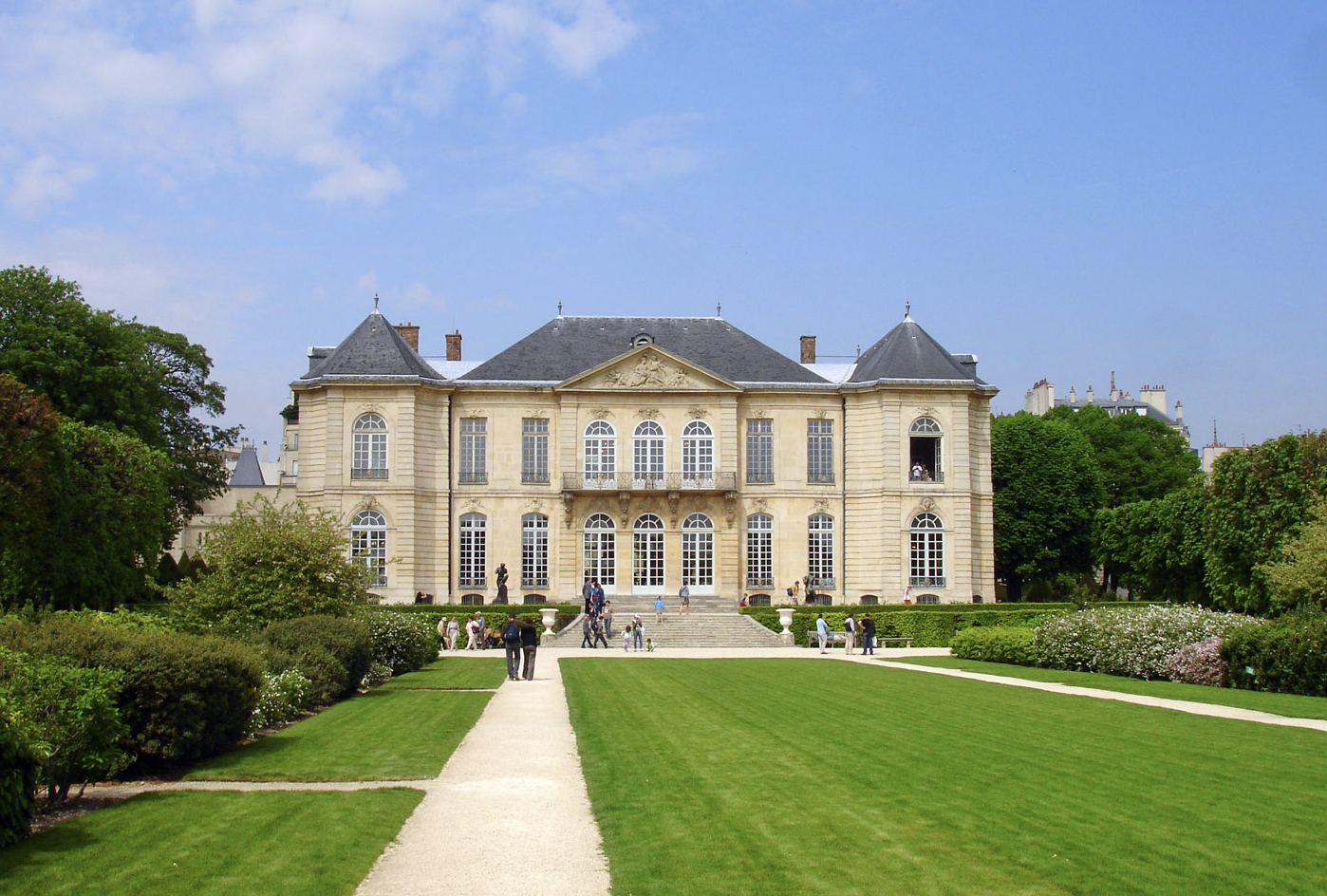
Musée Rodin, Paris. Image courtesy of Michael Scaduto via Wikimedia Commons
A famous example of Rodin copies coming under fire occurred in 2019, at the conclusion of a nearly two-decade legal controversy involving two art dealers, American Gary Snell and Frenchman Robert Crouzet. According to the court documents, Snell had cast upwards of 1,700 Rodin sculptures – a remarkable amount for one dealer. To make each sculpture, Snell used one of the sixteen molds illegally passed along to him by Crouzet. The alleged total sale price of the sculptures the pair sold amounted to over $72 million.
Snell and Crouzet might have been able to avoid prosecution for their reproductions, had they complied with the French law. For example, if Snell had made it clear to buyers that the reproductions were – in fact – reproductions, and not authentic Rodins, both Snell and Crouzet may have avoided liability. But because Snell failed to make it clear to buyers that they were buying reproductions, and not official copies, he and Crouzet both faced sentencing by the French State.
Several factors exacerbated the duo’s complicity, including the fact that some works included a forged Rodin signature. Many copies also included forged authentication documents from the official French foundry, the Founderie Rudier. Moreover, several of Snell’s copies departed from Rodin’s exact molds, creating sculptures that were slightly distorted. Snell was not a sympathetic plaintiff. He complained that if he had made it clear to buyers that he was selling unofficial reproductions, he likely would not have been able to charge as much per statue. Not to be outdone, his lawyer blurted out to the court that this lawsuit had “totally ruined” his client’s livelihood as an art dealer.
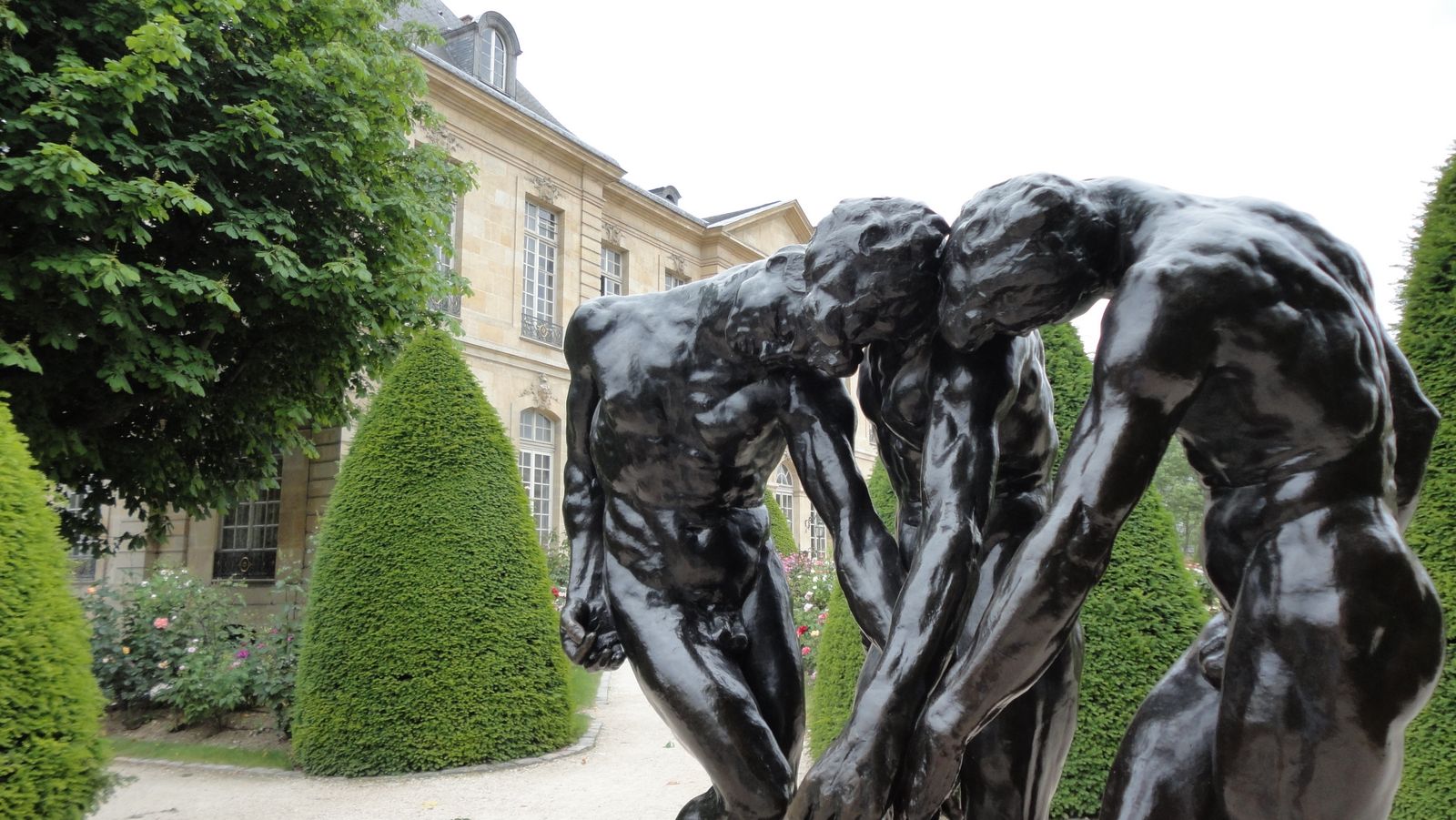
Rodin Museum, Paris
Copyright: Leila A. Amineddoleh
Such protestations did not result in a lot of love for Snell, Crouzet, or their attorneys. What is there to be said? The French State loves Rodin and will stop at nothing to protect and ensure the authenticity of the artist’s rich legacy. This level of devotion deserves a French kiss. However, in order to avoid a repeat of Dante’s ill-fated lovers, aim to make it Hershey’s.
by Amineddoleh & Associates LLC | Oct 13, 2021 |
 Our founder, Leila A. Amineddoleh, is serving as Chair of the New York County Lawyers Association’s 13th Annual Art Law Institute: New Insights in Art Law. The association’s annual conference has long been a highlight of the art law calendar each year. It’s typically been a full-day conference, but (like last year) it will be held over two half-days, October 21 and 22, via Zoom.
Our founder, Leila A. Amineddoleh, is serving as Chair of the New York County Lawyers Association’s 13th Annual Art Law Institute: New Insights in Art Law. The association’s annual conference has long been a highlight of the art law calendar each year. It’s typically been a full-day conference, but (like last year) it will be held over two half-days, October 21 and 22, via Zoom.
Leila organized this year’s conference and she will be speaking about the application of Foreign Sovereign Immunities Act in art and antiquities disputes. Associate Claudia Quinones will also be presenting during the conference, discussing ownership disputes in the ever-popular “What’s New in Art Law” panel. Please join us for the conference by registering (for either one day or for both days) HERE.
by Amineddoleh & Associates LLC | Aug 16, 2021 |
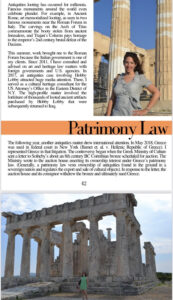 Our founder has been featured in the Art She Says summer 2021 French Riviera Issue. Her contribution to the magazine discusses art theft, forgeries, government ownership of cultural heritage, World War II restitution matters, and artists’ rights, with a particular focus on the firm’s work and her experience as an art lawyer. This includes our firm’s recent representation of the Italian and GreekMinistries of Culture in federal court. These were landmark cases, sending the message that foreign sovereigns can continue to monitor the art market without fearing lawsuits when making inquiries as to potentially looted antiquities’ whereabouts. The article also touches on the forfeiture of antiquities from Hobby Lobby, since Leila served as a cultural heritage consultant for the U.S. Attorney’s Office in that matter, and another forfeiture case concerning a 13th century painting.
Our founder has been featured in the Art She Says summer 2021 French Riviera Issue. Her contribution to the magazine discusses art theft, forgeries, government ownership of cultural heritage, World War II restitution matters, and artists’ rights, with a particular focus on the firm’s work and her experience as an art lawyer. This includes our firm’s recent representation of the Italian and GreekMinistries of Culture in federal court. These were landmark cases, sending the message that foreign sovereigns can continue to monitor the art market without fearing lawsuits when making inquiries as to potentially looted antiquities’ whereabouts. The article also touches on the forfeiture of antiquities from Hobby Lobby, since Leila served as a cultural heritage consultant for the U.S. Attorney’s Office in that matter, and another forfeiture case concerning a 13th century painting.
Leila’s contribution concludes with an overview of due diligence and intellectual property rights, which are crucial for private collectors, particularly with the vast number of forgeries and stolen works on the market. The magazine also includes photographs taken by Leila. We invite you to visit the Art She Says website and read the issue to discover more about Leila’s contribution, as well as the other interesting and valuable articles in the publication. Art She Says is the leading digital magazine that empowers women in the art world through the curation of luxury content, networking events, and art advisory services.
An online copy of the article is available HERE.
by Amineddoleh & Associates LLC | Dec 14, 2020 |
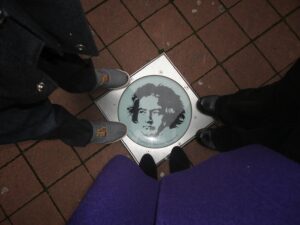
Street tile in Bonn, Germany (copyright: Leila Amineddoleh)
This month marks the 250th birthday of the legendary Ludwig van Beethoven. (There is no record of his actual birthdate, but his baptism on December 17, 1770 has led many to believe that he was born on December 16.) Recognized as one of the greatest figures in the world of classical music, his compositions are readily recognizable to people all over the world, including his dramatic Fifth Symphony, Fur Elise, the Second Movement of the Seventh Symphony (familiar to some from The King’s Speech), and the Ode to Joy from the final movement of his Ninth Symphony. Beethoven’s genius was instrumental in ushering in a new type of classical music, during a career that straddled the shift from the Classical to the Romantic era.
With his talent obvious from an early age, Beethoven began his musical career as a child. He was a virtuosic pianist and violinist, and clearly a talented composer. He gained fame during his lifetime, but also suffered the tragic loss of his hearing. However, his early life was not free from difficulty. He received harsh and intense musical training, often being dragged from bed in the middle of the night to practice the keyboard. By his late 20s, he began noticing difficulties with his hearing. By his mid-40s, he was totally deaf. Despite his medical condition, he persevered and continued to write staggeringly beautiful music that stirs audiences to this day.
As the writer of emotional and complex music, it is perhaps no surprise that he also wrote beautiful prose. He famously authored a celebrated love letter to a mysterious “Immortal Beloved.” The passionate letter was never sent to its intended recipient, whose identity is still a subject of debate. Beginning with “My angel, my all, my own self” and ending with “Ever thine. Ever mine. Ever ours,” the romantic missive has led to questions about the letter’s inspiration. (A translated copy of the letter can be found here.) Speculation about the woman’s identity inspired the film “Immortal Beloved,” whose theory of the identity is most certainly faulty. (Unfortunately, the film also represented Beethoven as a caricature of a tormented lothario and misunderstood artist.) A discussion about more probable candidates can be found here.

Amineddoleh & Associate’s founder at the Beethoven Haus
Besides the mystery surrounding the inspiration for the letter, its provenance is also interesting. The letter was written in pencil on 10 small pages, in the composer’s inconsistent handwriting. It was found in his estate after his death, and it remained with Anton Schindler, who had served as Beethoven’s secretary for a number of years, until his death. Unfortunately, Schindler was known to alter Beethoven’s personal documents and profited by plundering the composer’s legacy. Upon Schindler’s passing, the letter was bequeathed to Schindler’s sister, who in turn sold it in 1880 to the Berlin State Library. It remains there today. However, the date year of the writing was unclear until the mid-20th Century. An analysis of the paper’s watermark was completed in the 1950s, revealing that it was written on July 6-7, 1812 during a stay in Teplice, in the modern day Czech Republic. This is supported by a later letter by the composer to Rahel Varnhagen, suggesting that he had a meeting with his “Immortal Beloved” on July 3, 1812.
As with other famed composers and artists, forgeries of letters and manuscripts by Beethoven have cropped up over the years. Just four years ago, a purported manuscript by Beethoven failed to sell at Sotheby’s due to doubt cast upon its authenticity by musicologists and Beethoven scholars. One point of contention is the handwriting used in the manuscript; in particular, the notation of the natural sign. At Amineddoleh & Associates, we are proud to assist clients in authentication matters of all kinds, including documents and manuscripts, both musical and non-musical.
2020 was slated to be a year celebrating Beethoven’s birthday as one of the titans of the classical music world, with a calendar of performances and celebrations. Sadly, concertgoers were sorely disappointed as the events were cancelled due to COVID-19. However, in celebration of Beethoven’s staggering genius, WQXR (NY Public Radio) is currently hosting the program Immortal Beethoven. The station is available to listeners around the world. In addition, Beethoven Haus (the composer’s birthplace) in Bonn, Germany is hosting events for the composer this year. Due to the COVID-19 pandemic, the events are hosted online. For more information, visit the museum’s website. And for some lighter Beethoven entertainment, enjoy this clip from SNL.
Happy birthday Ludwig!





 Our founder, Leila A. Amineddoleh, is serving as Chair of the New York County Lawyers Association’s 13th Annual Art Law Institute: New Insights in Art Law. The association’s annual conference has long been a highlight of the art law calendar each year. It’s typically been a full-day conference, but (like last year) it will be held over two half-days, October 21 and 22, via Zoom.
Our founder, Leila A. Amineddoleh, is serving as Chair of the New York County Lawyers Association’s 13th Annual Art Law Institute: New Insights in Art Law. The association’s annual conference has long been a highlight of the art law calendar each year. It’s typically been a full-day conference, but (like last year) it will be held over two half-days, October 21 and 22, via Zoom. Our founder has been featured in the
Our founder has been featured in the 

